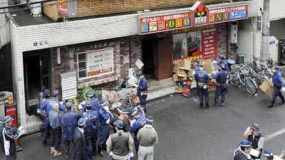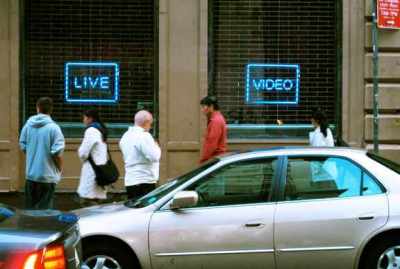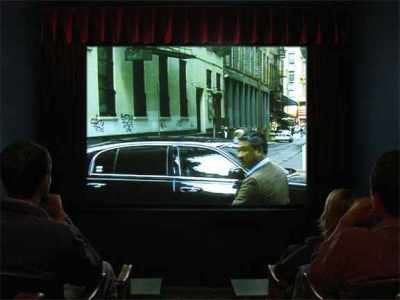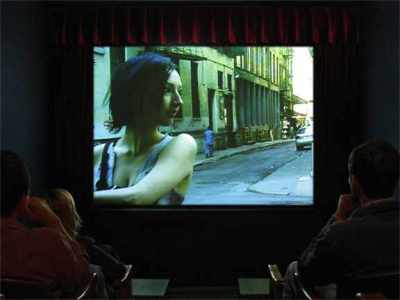
Wednesday, September 3, 2008 -- A large explosion in a Video parlour blast in the Ethiopian capital kills six.
Wednesday October 01, 2008 -- Fifteen men have died and 10 more people have been injured after a suspected arson attack on an all-night adult video parlour in Osaka, Japan.

Saturday, October 4, 2008 – Jan Baracz entraps visitors in his self-operated live video theatre at Art in General.
Sunday, October 5, 2008 -- In the eternal words of Baudritty (Baudrillard), “What are you doing after the orgy is over?” Nothing.
To survive the orgy indicates that you are already its victim. And this is precisely the approach of Baracz with his 2008 Art in General exhibition of the work, Live Video.
Allow me to just jump in ad hoc.

The work is an object. Baracz constructed a theatre after the heterotopic video parlours now being eradicated from the 21st century urban environment. He fetishized it, romanced the fetish, hysterically pushed it through an academic filter and then like the artists-artist, demands and awaits the result that its fiction/reality creates, in order to determine the assertion of the work itself. If Lacan where present, could he clarify such a perverse mirror on the fetishistic, albeit banal, object, itself; the prolific and yet contrary Baudrilliard would attempt it and Zizek would go balls out. But this realm of art is confused, paradoxical, neologistic and ultimately unfounded. So here we have a difficult work—pinning it down would be absurd.
Monday, October 6, 2008 – Again I revisit the theatre, wanting to pin it down, as I am handed a tissue from a stranger in a strange place and must determine for myself the experience that drives me. Although voyeurism is the sexual interest in spying on people engaged in intimate behaviors, such as undressing, sexual activity, or urinating, we all know that it is more simple, because we know that it is also the fear that we have a sexual interest in spying on people engaged in intimate behaviors, such as undressing, sex, and the like, into public, choreographed moments of gesture and loud, spontaneous private moments of response and introspection. Here, Baracz delivers the most banal, mundane of gestures—the escutcheoned image within the theatre is the live video footage of the street directly outside its entrance—and in this sense, could be any time, any space, Thailand seen by Thailand, Bucharest seen by Bucharest, etc.
Wednesday, October 8, 2008 – The schadenfreude of my existence begins to concern me, when I pass the theatre again. On this occasion, I did not enter. Like many pedestrians that can be viewed within the footage, I slow my step as I read the words, Live… Video… in neon on the street, considering. Should I enter at this moment, I would be Jeff in a wheel-chair, psycho-sexually denying Grace Kelly my attention in Hitchcock’s Rear (window)—the victim of late century latency.

Friday, October 10, 2008 – I forgive myself. From Mulvey to Zizek, it is posited that only men are allowed to view their desires projected onto the screen in such a patriarchal society, whereas women are there to be desired. She/He argues that the man will objectify a female figure whereas a woman will identify and empathize. Therein, my response to Live Video is human nature. I can, now, recognize this space as the equivalent of a "ready-made" just-as-is (telle quelle) transposition of an "everyday life" that has already been trumped by all dominant models. It is a synthetic banality, fabricated in closed circuits and supervised by a monitoring screen.
As Baurdillard cites: “Sex is everywhere else to be found, but that's not what people want. What people deeply desire is a spectacle of banality. This spectacle of banality is today's true pornography and obscenity. It is the obscene spectacle of nullity (nullité), insignificance, and platitude. This stands as the complete opposite of the theater of cruelty. But perhaps there is still a form of cruelty, at least a virtual one, attached to such a banality. At a time when television and the media in general are less and less capable of accounting for (rendre compte) the world's (unbearable) events, they rediscover daily life. They discover existential banality as the deadliest event, as the most violent piece of information: the very location of the perfect crime. Existential banality is the perfect crime. And people are fascinated (but terrified at the same time) by this indifferent "nothing-to-say" or "nothing-to-do," by the indifference of their own lives.”
Is this a Fascist Aesthetics or its unmaking? Is banality the word to use or the “pedestrian” as the artist himself suggests?
Sunday, October 12, 2008 – I accept latency. I do not fear it and the most basic possibility that my ego requires—a repetition of the mirror stage where one’s Ego begins formation by the result of identifying with one's own specular image, reflected.
After Lacan: At six months the baby still lacks coordination; however, they can recognize themselves in the mirror before attaining control over their bodily movements. The child sees their image as a whole, and the synthesis of this image produces a sense of contrast with the uncoordination of the body, which is perceived as a fragmented body. This contrast is first felt by the infant as a rivalry with their own image, because the wholeness of the image threatens them with fragmentation, and thus the mirror stage gives rise to an aggressive tension between the subject and the image.
Tuesday, October 13, 2008 – I watch the rainy night from a cushioned seat in Jan Baracz's Reality Cinema Storefront Theatre. I cannot determine whether I am subject or object. My sense of individuality and distinction from external objects is dissolved. I have become obscene, like the rest of the world.

In elevating the banal to spectacle, Baracz is elevating each of us as media objects. Hyperreality reigns over reality. He has exalted the collapse of the signified. Live Video demonstrates that the obscene lies in the fact that there is ‘nothing to see’ and that the spectator, rather than desiring difference from others, desires sameness with the subjects that he witnesses.
Thursday, October 15, 2008 – Having seen the object on the street, having realized that the object is my own reflection, having reconciled my addiction to this reflection, something new happens. A pedestrian passes by, his eyes lock upon the neon sign, Live Video, he looks directly into the window, projected on the screen, directly through it, directly at me and I am finally annihilated by the specter on the screen watching me.
Works Cited:
Baudrillard, Jean. The Ecstasy of Communication. Semiotext, New York, 1988.
Baudrillard, Jean. Dust Breeding. Ctheory, 2001.
Derrida, Jacques. Echographies of television. Malden, Mass. : Polity Press, 2002.
Virilio, Paul. Desert screen : War at the speed of light. London : Athlone, 2002.
Zizek, Slavoj. “How the Non-Duped Err”, Qui Parle 4, No 1 (1990):2.